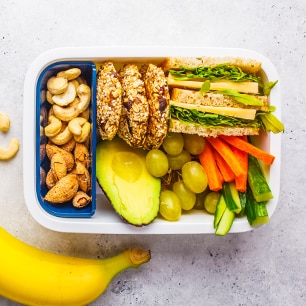Added sugars may be lurking in many of the products children love. Let’s do the math on decreasing added sugars in their diets.
According to the Dietary Guidelines for Americans 2015–2020, we should limit added sugars to less than 10 percent of daily calories.1 For a 2,000-calorie-per-day diet, this means no more than 200 calories, or 50 grams, of added sugars per day. The American Academy of Pediatrics recommends further reducing added sugar intake for children to no more than 25 grams (6 teaspoons) per day. Zero in on these simple steps to keep added sugars at a minimum for kids—especially in snacks, beverages, and meals.

Know Your Labels
Did you know that Nutrition Facts labels now include added sugars? The FDA requires manufacturers to disclose both the total sugar content and the amount of added sugars in a product.2 It’s easier than ever to check the label and see if foods are low or high in added sugars. Simply look at the % daily value (DV). Since labels often use grams, be sure you know the conversion of grams to teaspoons.
Conversion Shortcuts
5% DV or less = low in added sugars
20% DV or more = high in added sugars
4 grams = 1 teaspoon
In a 2,000-calorie diet, 10% DV is 50 grams of sugar, or 12 teaspoons.
Learn more about label updates for wise nutrition choices.
Look Out for Claims!
Keep track of added sugar intake. Find out what sugar claims on packaging actually mean.3
Sugar free = less than 0.5 grams of sugar per serving
Reduced sugar = at least 25% less sugar per serving than the regular version
No sugar added/without added sugars = no sugar or sugar-containing ingredients added during processing
Find out where added sugars may be hiding in common foods and beverages.
Beware of Beverages
Some of the biggest sugar culprits in children’s diets are beverages. Soft drinks, smoothies, juices, and sports drinks are popular and may comprise a large percentage of daily sugar intake for kids. Here are some simple ways to stay hydrated with less sugar:
- Keep it simple. Stick to milk and water as your child’s main beverages. Add flavor to water with fresh fruit, or try calorie-free sparkling waters.
- Be juice-wise. In moderation, 100% fruit juice can be part of a healthy diet, but be sure to keep the amount age appropriate.4 The American Academy of Pediatrics recommends no more than four ounces of 100% fruit juice a day for children ages 1–3; four to six ounces for ages 4–6; and eight ounces for ages 7–14.5
Quick tip: Look for 100% juice with no added sugars or fruit juice blends made without added sugars, such as GreenWise Organic Juice Pouches. - Hydrate right. Sports drinks may help kids stay hydrated during exercise by replenishing carbohydrates and electrolytes, ideally for activities lasting longer than
1–2 hours, or in very hot environments. For activities of less than an hour, water is generally sufficient.6 - Sweeten sparingly. It’s best to keep both added sugars and sugar substitutes to a minimum in children’s diets. Artificial sweeteners do not contain calories, but are often found in foods that fill kids up yet provide very little nutrition.7
Get more tips on how to rethink sugary drinks.
Smart Snacking
While many prepackaged snacks, such as smoothies, granola bars, and yogurt, may seem healthy, they can be high in added sugars. Look for our Better Choice shelf tags as you shop to identify options with less added sugar, and check out these tips:
- Make it fun. Kids may think of sugary foods as fun, but nutritious foods can be just as enticing. Get creative! Make a smiley face with sliced bananas and raisins. Cut fruit into shapes with cookie cutters. Encourage school-aged kids to invent new snacks.8
Quick tip: Dream up a family trail mix with items from your pantry, such as whole grain cereal, dried fruit, and unsalted nuts or seeds. - Blend away. Make a refreshing smoothie with plain fat-free or low-fat yogurt, 100% fruit juice, and frozen peaches. Or mix our Kids PB-Berry Smoothie recipe.9
- Get fruity. Fruit makes an easy grab-and-go snack. Pick up fresh, dried, canned, or frozen varieties.9
- Use recipe substitutes. Prepare homemade goodies with dried fruits—such as apricots or raisins—to reduce the amount of sugar in the recipe. Choose unsweetened applesauce or prune puree rather than butter or shortening to lower the fat content as well.9 Our delightful Banana-Nut Muffin Tops are naturally sweetened with bananas and dates.
- Find balance. While limiting sugary items, it’s important to help kids learn to make wise choices on their own. Banning or hiding sweets may fuel unhealthy cravings for sugar. Teach your child that an occasional dessert can be part of a balanced diet.4 Enjoy a sweet treat together once in a while!
Mealtime Tips
You may not think that meals contribute to your added sugar intake, but they certainly can, depending on your food choices. Pasta sauce, salad dressing, and other sauces often have more added sugars than you might expect.
Don’t be saucy! Dipping sauces such as ketchup, barbecue, honey mustard, and teriyaki add that zing of flavor kids love, but they also may add surprising amounts of the sweet stuff. It’s easy to keep pouring on the sauce. Take a look at the difference between the suggested serving sizes for these condiments and the actual amounts children may consume, including the added sugar content for both.
SIMPLE SAUCE COMPARISON
| Condiment | Suggested Serving Size | Actual Serving Size |
|---|---|---|
| Ketchup | 1 Tbsp = 4 g (8% DV) | 2–3 Tbsp = 8–12 g (16–24% DV) |
| Barbecue Sauce | 2 Tbsp = 10 g (20% DV) | 4 Tbsp = 20 g (40% DV) |
| Honey Mustard | 1 Tbsp = 3 g (6% DV) | 2–4 Tbsp = 6–12 g (12–24% DV) |
| Teriyaki Sauce | 1 Tbsp = 3 g (6% DV) | 2–4 Tbsp = 6–12 g (12–24% DV) |
Portion check. Since most condiments have a serving size of 1–2 tablespoons, eyeball them to help keep portions in check. Think of a tablespoon as roughly the size of your thumb.
Find a Better Choice. Compare labels to find the condiments with less added sugar. Keep an eye out for our Better Choice shelf tags as an easy shortcut. Another idea is to opt for regular mustard, salsa, or hummus, which tend to be lower in added sugars, to add the flavor you want.
Be naturally sweet. Start with recipes and meals that have natural sweetness, such as our Supreme Meatball Skewers with Italian Gravy. Rather than sauce from a jar with added sugars, this recipe features carrots, bell peppers, and onions—sautéed to bring out the natural sugars, which combine with tomatoes to create a balance of sweetness and acidity. Or you may choose to roast the veggies before making the sauce to caramelize the natural sugars. Either way, it’s a win!
For the Love of You
Choosing how you eat is uniquely personal. It’s about your needs, your preferences, and your goals. As your wellness ally, we’re in your corner with fresh ideas, recipes, and wellness icons that make it easier to shift toward wiser food choices. It’s all about you, at your very best.
Sources
1 U.S. Department of Health & Human Services (HHS). A Closer Look Inside Healthy Eating Patterns. 2015-2020 Dietary Guidelines for Americans, 8th ed. November 21, 2016.
2 U.S. Food & Drug Administration (FDA). Added Sugars on the New Nutrition Facts Label. March 11, 2020.
3 U.S. Food & Drug Administration (FDA). A Food Labeling Guide: Guidance for Industry. January 2013.
4 Fernando, Nimali, MD, MPH, FAAP. I Need a Treat: How to Tame Your Child’s Sweet Tooth. HealthyChildren.org. February 11, 2020.
5 American Academy of Pediatrics. How to Reduce Added Sugar in Your Child’s Diet: AAP Tips. HealthyChildren.org. March 25, 2019.
6 Kinsella, Sarah, MD, CAQ, FAAP. Sports Nutrition for Busy Families and Busy Lifestyles. HealthyChildren.org. March 6, 2017.
7 Ansel, Karen, MS, RDN, CDN. Are Artificial Sweeteners Safe for Kids? EatRight.org. Academy of Nutrition and Dietetics. June 6, 2019.
8 U.S. Department of Agriculture (USDA). 10 Tips: Cut Back on Your Kid’s Sweet Treats. ChooseMyPlate.gov. January 2016.
9 U.S. Department of Agriculture (USDA). 10 Tips: MyPlate Snack Tips for Parents. ChooseMyPlate.gov. January 2016.

 You are about to leave publix.com and enter the Instacart site that they operate and control. Publix’s delivery and curbside pickup item prices are higher than item prices in physical store locations. Prices are based on data collected in store and are subject to delays and errors. Fees, tips & taxes may apply. Subject to terms & availability. Publix Liquors orders cannot be combined with grocery delivery. Drink Responsibly. Be 21. For prescription delivery, log in to your pharmacy account by using the Publix Pharmacy app or visiting
You are about to leave publix.com and enter the Instacart site that they operate and control. Publix’s delivery and curbside pickup item prices are higher than item prices in physical store locations. Prices are based on data collected in store and are subject to delays and errors. Fees, tips & taxes may apply. Subject to terms & availability. Publix Liquors orders cannot be combined with grocery delivery. Drink Responsibly. Be 21. For prescription delivery, log in to your pharmacy account by using the Publix Pharmacy app or visiting 
